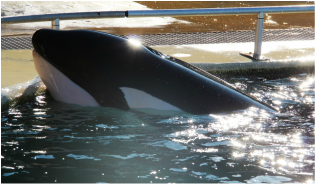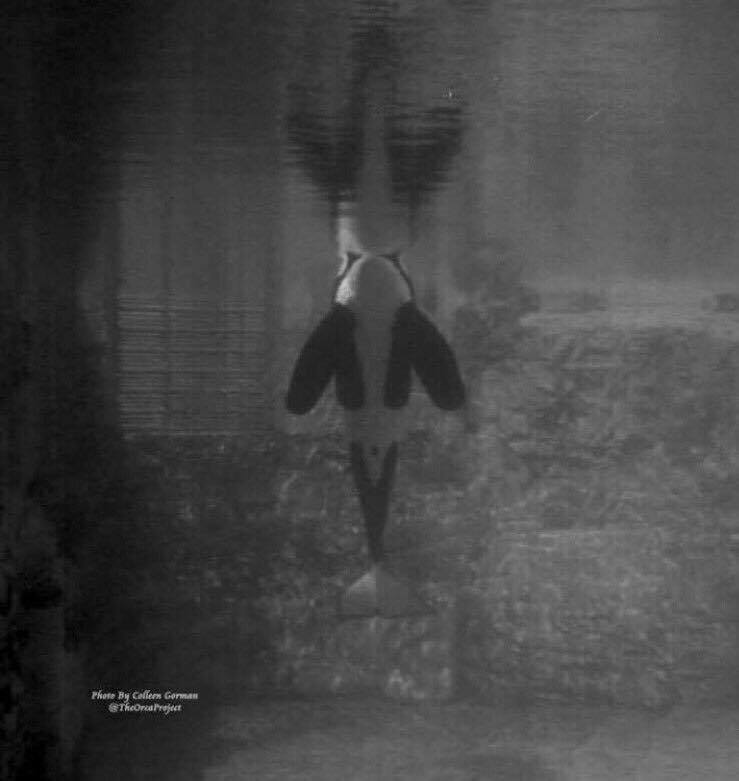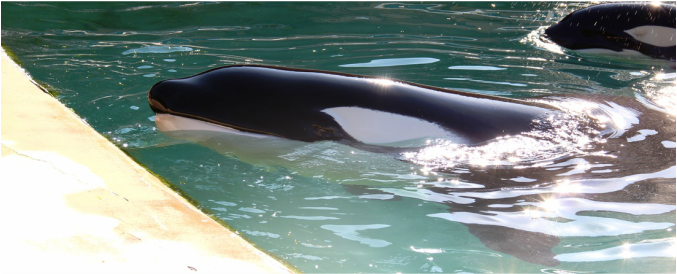Captive Orca Tilikum, Star of the 'Blackfish' Movie, Has Died at SeaWorld - But His Legacy Lives On6/1/2017 Today the orca community has suffered a devastating loss. Tilikum, the much loved star of 'Blackfish' and captive of Seaworld Orlando for the last 25 years, has passed away. In the wild, male orca can live up to 50-60 years of age; Tilikum died at the estimated age of 36. SeaWorld has said, “The SeaWorld family is deeply saddened to announce that one of its most well-known orcas, Tilikum, has passed away. Tilikum passed away early this morning, January 6, surrounded by the trainers, care staff and veterinarians that provided him around-the-clock world-class care.” Tilikum was the largest orca in captivity, measuring 22.5 feet in length and weighing in at over 12,000 lbs. He had a very distinct dorsal fin measuring 6.5 feet which was completely collapsed to his left side. He was believed to be a North Atlantic Type 1 orca from the resident fish-eating population that inhabits Icelandic waters. Tilikum was one of over 50 orca captured in Icelandic waters. He was captured in 1983 at the age of two, along with Samoa and Nandu. Immediately after his capture, he was held in a small, concrete holding tank for almost a year near Reykjavik, before being transferred to Sealand of the Pacific in Victoria, Canada. As a juvenile, he was refused food if he did not perform tricks and was often 'raked' and bullied by the two larger females in his tank. He was transferred to Seaworld in 1992 where he lived out the rest of his life performing in Shamu shows and siring multiple offspring. Tilikum was associated with the deaths of three humans during his life in captivity. The first was in February 1991 at Sealand of the Pacific. Keltie Byrne, a 20 year old orca trainer at Sealand, slipped into the pool and was repeatedly pulled underwater by Tilikum and the two females in his tank, until she ultimately drowned. In July 1999, civilian Daniel P. Dukes was found naked, draped over the back of Tilikum in his SeaWorld orca tank. Dukes had reportedly hidden in the park after closing and entered the orca pool, unbeknown to security staff. Although hypothermia and ultimately drowning were given as the cause of death, Dukes sustained multiple blunt-force traumas pre and post mortem. In February 2010, Tilikum was involved in the death of one of Seaworld's most senior trainers: Dawn Brancheau. During a routine "Dine with Shamu" event, Tilikum reportedly grabbed the trainer by the arm and dragged her into the pool. She too sustained horrific trauma and it was Brancheau’s death that ignited the captive orca welfare movement as we know it today. Following this trainer's death, Seaworld was banned from putting trainers in the water with orca. To date, Tilikum has sired 21 offspring, only ten of which are still alive today. His first calf, Kyuquot, was born in December 1991 at Sealand and later transferred to Seaworld San Antonio. At 24 years of age, Kyuquot is the oldest of Tilikum’s offspring. Tuar (1999), Nakai (2001), Ikaika (2002), Malia (2007), Sakari (2010) and Makaio (2010) currently live in Seaworld’s American amusement parks, while Tekoa (2000), Kohana (2002, whose own calves resulted from inbreeding) and Skyla (2004) reside in Loro Parque, Tenerife, on loan from SeaWorld, along with another SeaWorld orca who also killed his trainer. Five of Tilikum’s calves were stillborn, while others died from disease and chronic health issues. During his time at SeaWorld, Tilikum formed a close companionship with Taima, fathering all of her calves until she died during labour in 2010.
Alongside Keiko, the star of the movie 'Free Willy', Tilikum was arguably the most well-known orca in captivity due to the 2013 documentary 'Blackfish'. Throughout the film, former Seaworld trainers talk about their experiences with Tilikum. They highlight the fact that trainers were not made aware of Tilikum’s dangerous past before they started interacting with him, and that the initial reports released by Seaworld surrounding Brancheau’s death hinted at ‘trainer error’ despite several eye-witness accounts stating otherwise. The film had a huge impact and raised awareness of the conditions and controversies of orca captivity. It was following this now wide-reaching awareness of the impacts on orca welfare due to captive confinement that SeaWorld announced it would be ending its captive orca breeding programme. This surprising and welcome change of direction followed news that Tilikum had fallen seriously ill back in March 2016. At the time, there appeared to be a lack of transparency in understanding what was wrong with Tilikum and whether confinement was the cause of his deterioration. Now, SeaWorld has stated that, “…The official cause of death will not be determined until the necropsy is completed, the SeaWorld veterinarians were treating a persistent and complicated bacterial lung infection. The suspected bacteria is part of a group of bacteria that is found in water and soil both in wild habitats and zoological settings.” Prior to today’s announcement, the last update on Tilikum’s progress was released by Seaworld on 31 August 2016, indicating that he had been making good progress towards recovery. Unfortunately, this was not the case. Tilikum is now gone, but he leaves behind a poignant legacy: He will forever remind us of the tragedy that can occur, for both orca and humans alike, when freedom and choice is stolen from sentient beings designed by nature to be wild and free. Tilikum has found his freedom - we are sorry that it was in death he had to find it.
9 Comments
Orca Wikie, Asked To Beach On Her Birthday, Has Already Produced Two Assets At Only 15 Years of Age28/6/2016  On June 1st of this year, Marineland Antibes celebrated orca Wikie’s birthday by instructing her to beach so that staff could pose with her for a photo. Despite Wikie turning 15 years old, the captive-born Icelandic orca has already produced two assets for the French entertainment park. According to 52 Orcas, when Wikie was only eight years old, she "became the youngest orca to be artificially inseminated...in a collaboration between Marineland [Antibes] and SeaWorld. The resulting offspring did not survive." In March 2011, however, Wikie did successfully give birth to Moana - Wikie was nine years old. Just two years and eight months later, when Wikie was still only twelve years old, she produced a second calf. Keijo was born in November 2013 and is believed to be inbred, having reportedly been sired by Wikie's recently deceased half-brother. In the wild, orca do not typically give birth to their first calf until they are around 14 years of age and they usually only produce one calf every three or more years. Free-ranging orca are also known to rely on their social groups to help raise their young. At Marineland Antibes, Wikie does not have a normal social group and she is still a youngster herself. Her half-brother Valentin died last year during the time when the orca tanks at Marineland Antibes were flooded with mud and Valentin's mother Freya died just four months before her son. Wikie is now the only remaining female at the entertainment park, kept in a tank with her two male offspring and Inouk, her only surviving brother. Despite SeaWorld announcing the end of its captive orca breeding programme, Marineland Antibes has said it will continue. Given that SeaWorld's orca are now unavailable and all of Marineland Antibes' own orca are related, it remains unclear at this time which individuals Marineland Antibes will use in its breeding programme going forward. There are, however, rumours that Wikie is already pregnant again. And if this is true, it is even more concerning, for both Wikie and her unborn calf, that Marineland Antibes has instructed this 4,500lb orca to beach herself for a photograph. Read The Orca of Marineland Antibes to find out more about the entertainment park's captive orca, both past and present, and visit the Marineland Antibes Tweetsheet to help tell their stories. Wikie (top) & Wikie with Moana (bottom) - all photos © Orca Aware
"What's going on inside the brains of animals? Can we know what, or if, they're thinking and feeling?" Talking whales, wolves and more, watch Carl Safina's TED talk below. You can also visit his TED talk page: https://www.ted.com/talks/carl_safina_what_are_animals_thinking_and_feeling The necropsy of 'Lulu', from the UK's West Coast Community orca population, has revealed that she most likely died as a result of entanglement - this is tragic news and is another stark reminder of the polluted state of our oceans. There may be as few as eight individuals left in this population and no calves have been produced since studies on these individuals began.
In a statement released by the Scottish Marine Animal Stranding Scheme (SMASS), team members Dr. Andrew Brownlow, Nick Davison and Mariel ten Doeschate have said, "Hi folks A very unfortunate but interesting first necropsy for 2016. We’re out on the Isle of Tiree at the moment having necropsied an adult female killer whale (Orcinus orca). This animal has been identified as ‘Lulu’, one of the animals from the Scottish west coast community. By the time we had heard of her stranding and travelled to Tiree, she had been dead for 4 days, so much of the internal organ structure had been lost. Nonetheless we found convincing evidence that she had become chronically entangled and this was the most likely cause of her death. There were deep, granulating wounds around the tailstock and tell-tale twin linear abrasions on the underside of the tail fluke. These are consistent with a rope wrapping around the tail and trailing behind the animal, probably still attached to something at the other end. This would have made normal swimming very difficult, and we suspect the animal had been entangled for several days. She hadn’t fed recently but had swallowed a large amount of seawater, most likely as she eventually succumbed to the entanglement and drowned. There were no ropes or gear left on the carcase; we’re assuming all this from the lesions we found on her body, so we don’t know if this was due to active fishing gear, abandoned or ‘ghost’ gear, or other marine debris. The lesions are very similar however to those we see from creel rope entanglement in baleen whales. This is the first killer whale we have seen which has been entangled, although we have had an increase in entanglement incidence in other large cetaceans over the past year. These types of mortality are particularly tragic, however from examining this case we should be able to learn a little more about a poorly understood population. We have samples to examine age, reproductive status and pollutant burden, and this will form part of future studies. Andrew, Nick and Mariel SMASS" You can find out more about Scheme's work here. There's been some very sad news for the UK's West Coast Community orca population!
An orca known as 'Lulu' was found dead yesterday on Tiree in Scotland. There may now be as few as eight individuals left in this population. The Hebridean Whale and Dolphin Trust stated: "We have some sad news to report: one of the West Coast Community of killer whales known as 'Lulu' was found dead yesterday on Tiree. She was last photographed by us from Silurian off Waternish, Isle of Skye in July 2014. Dr Andy Foote, a killer whale specialist, confirmed the photo-id match which was made using the distinctive eye and saddle patches which are unique to individuals. TheScottish Marine Animal Strandings Scheme are hoping to conduct an examination which might shed light on the cause of death. It is particularly sad to know that another one of these killer whales, unique to the British and Irish Isles has died. There may be as few as 8 individuals remaining in this population, which has not produced calves since studies began." The Hebridean Whale and Dolphin Trust also holds the West Coast Community identification catalogue. An orca calf has sadly been found dead off the coast of Canada. At this time, it is unclear where the calf has come from, although it doesn't appear to be from the Southern resident population.
Find out more: http://kval.com/outdoors/dead-baby-orca-found-washed-up-on-vancouver-island-12-30-2015 Update (15th January 2016): The calf found dead in Canada was found to be from the Gulf of Alaska transient population, though the cause of death is still unknown. Find out more: http://www.wireservice.ca/index.php?module=News&func=display&sid=18016 Captive orca 'Unna' has died at SeaWorld San Antonio today after suffering from a fungal infection (Candida) over the last few months.
Unna was born on 27th December 1996 to wild-caught Icelandic orcas Katina and Tilikum. In 2006, Unna gave birth to a stillborn female calf; unless Unna was artificially inseminated, the calf was inbred as Unna only lived with relatives at the time. She was 18 years-old when she died on 21st December 2015, several days before her nineteenth birthday. Another new calf has been born in the Southern resident orca population - this time to J-pod. The orca has been designated J54.
Find out more from the Center for Whale Research (with photo): https://www.facebook.com/CenterForWhaleResearch/photos/a.385286821490832.101410.276095682409947/1085094748176699/?type=3&theater An orca has sadly stranded and died in Plettenberg Bay, South Africa. A necropsy is being conducted to determine the cause of death.
Source: https://www.facebook.com/DivePlett/photos/a.495385003892216.1073741829.473830842714299/863103600453686/?type=3 Update (18th December): The necropsy has revealed its stomach contained litter, including yoghurt pots, a shoe sole and food wrappings. Find out more: http://www.news24.com/SouthAfrica/News/sad-story-emerges-of-pletts-stranded-orca-20151217 A former SeaWorld diver, who left the company in 2013, has shared her experiences of diving in the orca and other animal tanks at SeaWorld. Read here: https://www.thedodo.com/seaworld-orcas-peel-skin-off-each-other-1498617162.html
|
Archives
January 2017
|



 RSS Feed
RSS Feed
